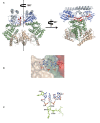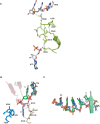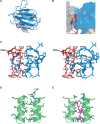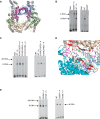Crystal structure of the UvrB dimer: insights into the nature and functioning of the UvrAB damage engagement and UvrB-DNA complexes
- PMID: 22753105
- PMCID: PMC3458569
- DOI: 10.1093/nar/gks633
Crystal structure of the UvrB dimer: insights into the nature and functioning of the UvrAB damage engagement and UvrB-DNA complexes
Abstract
UvrB has a central role in the highly conserved UvrABC pathway functioning not only as a damage recognition element but also as an essential component of the lesion tracking machinery. While it has been recently confirmed that the tracking assembly comprises a UvrA2B2 heterotetramer, the configurations of the damage engagement and UvrB-DNA handover complexes remain obscure. Here, we present the first crystal structure of a UvrB dimer whose biological significance has been verified using both chemical cross-linking and electron paramagnetic resonance spectroscopy. We demonstrate that this dimeric species stably associates with UvrA and forms a UvrA2B2-DNA complex. Our studies also illustrate how signals are transduced between the ATP and DNA binding sites to generate the helicase activity pivotal to handover and formation of the UvrB2-DNA complex, providing key insights into the configurations of these important repair intermediates.
Figures







Similar articles
-
Dynamics of the UvrABC nucleotide excision repair proteins analyzed by fluorescence resonance energy transfer.Biochemistry. 2007 Aug 7;46(31):9080-8. doi: 10.1021/bi7002235. Epub 2007 Jul 14. Biochemistry. 2007. PMID: 17630776
-
Real-time investigation of the roles of ATP hydrolysis by UvrA and UvrB during DNA damage recognition in nucleotide excision repair.DNA Repair (Amst). 2021 Jan;97:103024. doi: 10.1016/j.dnarep.2020.103024. Epub 2020 Nov 25. DNA Repair (Amst). 2021. PMID: 33302090
-
Crystal structure of Bacillus stearothermophilus UvrA provides insight into ATP-modulated dimerization, UvrB interaction, and DNA binding.Mol Cell. 2008 Jan 18;29(1):122-33. doi: 10.1016/j.molcel.2007.10.026. Epub 2007 Dec 27. Mol Cell. 2008. PMID: 18158267 Free PMC article.
-
The nucleotide excision repair protein UvrB, a helicase-like enzyme with a catch.Mutat Res. 2000 Aug 30;460(3-4):277-300. doi: 10.1016/s0921-8777(00)00032-x. Mutat Res. 2000. PMID: 10946234 Review.
-
Role of ATP hydrolysis by UvrA and UvrB during nucleotide excision repair.Res Microbiol. 2001 Apr-May;152(3-4):401-9. doi: 10.1016/s0923-2508(01)01211-6. Res Microbiol. 2001. PMID: 11421287 Review.
Cited by
-
Investigation of bacterial nucleotide excision repair using single-molecule techniques.DNA Repair (Amst). 2014 Aug;20:41-48. doi: 10.1016/j.dnarep.2013.10.012. Epub 2014 Jan 25. DNA Repair (Amst). 2014. PMID: 24472181 Free PMC article. Review.
-
Single-molecule studies of helicases and translocases in prokaryotic genome-maintenance pathways.DNA Repair (Amst). 2021 Dec;108:103229. doi: 10.1016/j.dnarep.2021.103229. Epub 2021 Sep 20. DNA Repair (Amst). 2021. PMID: 34601381 Free PMC article. Review.
-
Prokaryotic nucleotide excision repair.Cold Spring Harb Perspect Biol. 2013 Mar 1;5(3):a012591. doi: 10.1101/cshperspect.a012591. Cold Spring Harb Perspect Biol. 2013. PMID: 23457260 Free PMC article. Review.
-
An aromatic-rich loop couples DNA binding and ATP hydrolysis in the PriA DNA helicase.Nucleic Acids Res. 2016 Nov 16;44(20):9745-9757. doi: 10.1093/nar/gkw690. Epub 2016 Aug 2. Nucleic Acids Res. 2016. PMID: 27484483 Free PMC article.
-
Repair of hydantoin lesions and their amine adducts in DNA by base and nucleotide excision repair.J Am Chem Soc. 2013 Sep 18;135(37):13851-61. doi: 10.1021/ja4059469. Epub 2013 Sep 5. J Am Chem Soc. 2013. PMID: 23930966 Free PMC article.
References
-
- Van Houten B, Croteau DL, DellaVecchia MJ, Wang H, Kisker C. ‘Close-fitting sleeves’: DNA damage recognition by the UvrABC nuclease system. Mutat. Res. 2005;577:92–117. - PubMed
-
- Truglio JJ, Croteau DL, Van Houten B, Kisker C. Prokaryotic nucleotide excision repair: the UvrABC system. Chem. Rev. 2006;106:233–252. - PubMed
-
- Friedberg EC, Walker GC, Siede W. DNA Repair and Mutagenesis. Washington DC: ASM Press; 1995.

